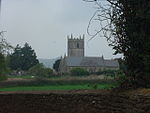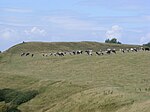Stanton Drew stone circles

The Stanton Drew stone circles are just outside the village of Stanton Drew in the English county of Somerset. The largest stone circle is the Great Circle, 113 metres (371 ft) in diameter and the second largest stone circle in Britain (after Avebury); it is considered to be one of the largest Neolithic monuments to have been built. The date of construction is not known, but is thought to be between 3000 and 2000 BCE, which places it in the Late Neolithic to Early Bronze Age. It was made a scheduled monument in 1982.The Great Circle was surrounded by a ditch and is accompanied by smaller stone circles to the northeast and southwest. There is also a group of three stones, known as The Cove, in the garden of the local pub. Slightly further from the Great Circle is a single stone, known as Hautville's Quoit. Some of the stones are still vertical, but the majority are now recumbent, and some are no longer present. The stone circles have been studied since John Aubrey's visit in 1664, and some excavations of the site were performed in the 18th century. In the late 20th and early 21st centuries, geophysical surveys have confirmed the size of the stone circles and identified additional pits and postholes. The Cove has been shown to be around 1000 years older than the stone circles, and so date from 4000-3000 BCE. A variety of myths and legends about the stone circles have been recorded, including one about dancers at a celebration who have been turned to stone.
Excerpt from the Wikipedia article Stanton Drew stone circles (License: CC BY-SA 3.0, Authors, Images).Stanton Drew stone circles
Sandy Lane,
Geographical coordinates (GPS) Address Nearby Places Show on map
Geographical coordinates (GPS)
| Latitude | Longitude |
|---|---|
| N 51.3671143 ° | E -2.5760409 ° |
Address
Stanton Drew Great Circle (Stanton Drew Great Stone Circle;The Great Circle)
Sandy Lane
BS39 4EL
England, United Kingdom
Open on Google Maps











